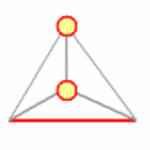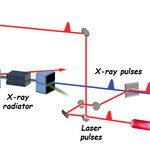Physics

Reflecting an interest that I've had for some time, that has been rekindled due to its inherent entanglement with my fundamental area of research - the nature of time, I am releasing the first of a three part series on black holes that will raise new questions and hopefully answer them. I had intended to just do one or two but, after reviewing the available data, I determined that there was enough to do three separate pieces and also offer the opportunity to collaborate to a certain degree, with experts in the field who would be more familiar with the math of black hole physics. I have…

Reflecting an interest that I've had for some time that has been rekindled due to its inherent entanglement with my fundamental area of research - the nature of time, I am releasing the first of a three part series on black holes that will raise new questions and hopefully answer them. I had intended to just do one or two but after reviewing the available data I determined that there was enough to do three separate pieces and also offer the opportunity to collaborate to a certain degree, with experts in the field who would be more familiar with the math of black hole physics. I have…
Scientists have discovered the world's smallest superconductor, a sheet of four pairs of (BETS)2GaCl4 molecules less than one nanometer wide.
Their new Nature Nanotechnology study provides the first evidence that nanoscale molecular superconducting wires can be fabricated, which could be used for nanoscale electronic devices and energy applications.
"Researchers have said that it's almost impossible to make nanoscale interconnects using metallic conductors because the resistance increases as the size of wire becomes smaller. The nanowires become so hot that they can melt and destruct. That…
One of the original things that I've done in terms of reserach, has to do with super massive black holes and how they don't fit into a single reference frame from all points of view. I presented this fact as part of my original SuperScience for High School Physics presentation.
News Release Number: STScI-1995-47
Hubble Finds a New Black Hole - and Unexpected New Mysteries
Go to image download page
Confirming the presence of yet another super-massive black hole in the universe, astronomers using the Hubble telescope have found unexpected mysteries. The black hole and an 800-light-year-…

Kim Griest Physics Department 0319 University of California, San DiegoLa Jolla, CA 92093
Offices:
3202 Mayer Hall, 858-534-0924
337 SERF, 858-534-8914
Griest/Fuller Lab: 4217 Mayer Hall, 858-534-5687
Secretary: Judy Winstead, 4242 Mayer Hall, 858-534-1082
FAX: 858-534-0173
ttp://www.engr.mun.ca/~ggeorge/astron/blackholes.htmlhttp://www.engr.mun.ca/~ggeorge/astron/shad/index.html#falling (includes important diagrams)
http://www.astronomy.com/asy/default.aspx?c=a&id=9420
http://www.phys.utk.edu/daunt/Astro/StudyGuides/BlackHoles.html

The "exceptionally simple theory of everything," proposed by physicist Antony Garrett Lisi in 2007 does not hold water, according to a particle physicist and mathematician writing in Communications in Mathematical Physics.
In November of 2007, Lisi published an online paper entitled "An Exceptionally Simple Theory of Everything." The paper centered on the elegant mathematical structure known as E8, which also appears in string theory. First identified in 1887, E8 has 248 dimensions and cannot be seen, or even drawn, in its complete form.
The enigmatic E8 is the largest and most complicated…

Two and a half months since Erik Verlinde submitted his entropic gravity paper, and all of physics and cosmology has turned into entropy. Well, I am exaggerating a bit, and perhaps more than just a bit. Yet, fact is that within two weeks of Erik's publication a steady stream of 'entropic everything' papers has developed at a rate of close to one paper per day. Gravity, Einstein's equations, cosmic expansion, dark energy, primordial inflation, dark mass: it's all entropic. Chaos rules. Entropy is king!
Or is it?
Could it be that an 'entropic bandwagon' has started rolling? Is this all not…

Quantum mechanics has been around for a hundred years and continues to fascinate and astonish scientists. It has been phenomenally successful at explaining the microscopic universe at the level of atoms and elementary particles and yet classical mechanics has survived to model the macroscopic world of everyday objects. But at what level do these two theories meet? Is there a region in which they could overlap; that is, can macroscopic objects display quantum behaviour?
Anybody who has had more than a cursory look at quantum mechanics will have come across the correspondence principle, which…

The number in the title, interpreted in units per square centimeters per second, is a flux rate, and it is a new world record set by the Tevatron collider last night on the number of protons and antiprotons forced to cross each other within a tiny interaction region in the core of the CDF and DZERO experiments.
It thus looks like the Tevatron is unwilling to let the spotlight be stolen by the imminent runs at 7 TeV by the Large Hadron Collider. Nevertheless, with not little fair play, the front page of the Fermilab web site still features a story on the 1.18 TeV world record of the LHC proton…

By changing the material medium through which x-rays pass, physicists at Lawrence Berkeley National Laboratory have used laser light to control x-ray beams.
As a new generation of powerful light sources comes online, intense x-ray beams may be able to control matter directly and allow one beam of x-rays to control another, the new Nature Physics study suggests.
Using the Lawrence Berkeley National Laboratory's Advanced Light Source femtosecond spectroscopy beamline 6.0.2, researchers sent ultrashort pulses of laser light and higher-frequency x-rays together through a gas cell filled with…